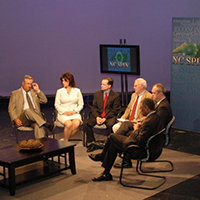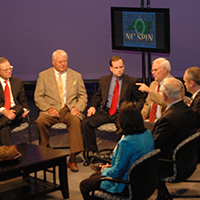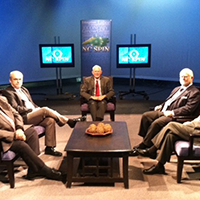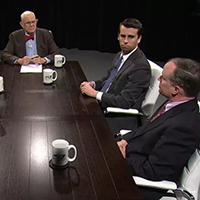State of Judicial emergency
Published March 19, 2015
by Sharon McCloskey, NC Policy Watch, March 18, 2015.
The federal courts in eastern North Carolina have been operating under a state of judicial emergency for years now, though you wouldn’t know it given the lack of a sense of urgency exhibited by the state’s United States senators.
Down a judge since December 2005, the courts in this largely rural part of the state have managed one of the heavier district caseloads in the country — relying in large part on help from three senior judges: James C. Fox, age 86; W. Earl Britt, age 83; and Malcolm Howard, age 75.
For a while these past few years, it looked like help might be on the way with the President’s nomination of Jennifer May-Parker to fill the slot left open when U.S. District Judge Malcolm Howard took senior status nearly ten years ago.
May-Parker would have been the first African-American to serve in the Eastern District – a milestone certainly given the large black population in that part of the state and the otherwise all-white and overwhelmingly male composition of the federal district courts there.
But U.S. Senator Richard Burr, who for years took his senate colleagues to task for holding up judicial nominations, inexplicably blocked that nomination by refusing to submit the “blue slip” evidencing his support – a critical step to moving a judicial candidate to a senate hearing.
May-Parker’s nomination has since lapsed, with no new nominee on the horizon.
And while the Senate in its waning days of Democratic control managed to push through another African-American woman — Loretta Copeland Biggs — to serve as federal judge in central North Carolina, the prospects of getting new nominees approved are not promising, given the intransigence on Capitol Hill now.
The ongoing confirmation delay of North Carolina-born U.S. Attorney General nominee Loretta Lynch is a testament to that.
Away from the political fray, the district’s judges have been doing yeoman’s work in moving cases, but like many courts across the country, that’s taking longer.
Relying on judges in their eighties to carry a significant load cannot be a long-term solution.
Filling the current vacancy is the obvious answer, though not likely to happen in the short term.
But there’s another route to easing the load in the Eastern District, one that can be pursued while efforts at filling the vacancy continue: get more judge slots.
The Eastern District currently has four Congressionally-approved judgeships, but its case numbers — as assessed by federal court administrators and researchers alike — warrant at least one more in addition to the already-existing vacancy. .
Many districts across the country have pushed to get more judgeship positions approved, and in January, the Judicial Conference of the United States asked Congress to do just that – submitting a list of districts recommended for increases.
Unfortunately, the Eastern District did not make the cut.
Nationwide, higher caseloads, fewer judges, slower resolution
The number of authorized judgeships across the country has not kept pace with the steadily growing number of federal court filings, a conclusion supported in detail in this October 2014 report from the Transactional Records Access Clearinghouse (TRAC) at Syracuse University.
Over a twenty-year period, federal court filings across the country grew by 28 percent — from 275,323 in 1993 to 353,522 in 2013. According to the U.S. Administrative Office of the Courts, that number grew again to 358,032 in 2014, counting criminal filings by cases. (Counting criminal filings by number of defendants instead pushes that number up to 376,536).
But over the same period of time, the number of judgeships authorized by Congress for each federal district barely changed, up only four percent from 649 in 1993 to 677 in 2013. And the number of actual full-time judges filling those slots — given vacancies — dropped to 612, according to TRAC.
Fewer judges handling rising caseloads means that it’s taking longer for cases, especially civil ones, to get to trial. Data collected by the federal courts show that it now takes 63 percent longer for a civil case to get to trial. In 1993 it took 16 months; in 2013, 23 months.
Numbers from the Eastern District fall in line with this trend. For the year ending September 2014, it took an average of 27 months from filing for a civil case to get to trial. In 2013, that number was 22 months, and in 2012, 45 months.
“It is clear from the analysis that federal courts in America are experiencing unprecedented pressure due to increased filings and stagnant resources,” the TRAC report‘s authors concluded. “The end result is that the federal courts are taking significantly longer to adjudicate both civil and criminal disputes, an outcome that has important social, economic and justice implications for the nation.”
Counting cases
Case numbers can fluctuate widely across the country as well as across a single district and, without more, can be misleading as an indicator of actual judicial workloads.
For example, judges handling multi-district litigation often have thousands of cases on their docket, filed by plaintiffs asserting essentially the same legal claim in separate actions and handled in consolidated fashion.
That explains the 3,008 cases U.S. District Judge Billy Roy Wilson in Arkansas closed during the year ending June 30, 2014 – some of the more than 9,700 cases filed against Wyeth Pharmaceuticals, maker of the controversial drug Prempro.
Other judges may have lower numbers but more complex and time-consuming cases.
In an effort to capture actual workloads, the federal courts count cases in a weighted fashion, mathematically adjusting filings based upon the nature of the case and the amount of time that a judge would likely spend on it. For example, in federal district courts each civil antitrust case is counted as 3.45 cases, while each homicide defendant is counted as 1.99 weighted cases.
The office then divides that weighted number of cases in a district by the number of authorized judgeships there to come up with the workload.
But using authorized judgeships can be somewhat misleading, giving credit for handling a workload to an illusory judge in districts operating with vacancies.
Researchers at TRAC looked at the work being done by actual sitting full-time judges instead and found that on average in 2013 the number of civil and criminal cases assigned to a federal district court judge was 364.
By either method, the Eastern District’s weighted caseload is among the heaviest in the country – 581 cases per judge (for the 12-month period ending September 2014) according the AOC and 455 per the TRAC report (for the 12-month period ending June 30, 2014).
Authorizing new judgeships
It’s been more than two decades since Congress passed a comprehensive judgeship bill authorizing increases in the number of judges serving in districts across the country.
But staggering caseloads in recent years have pushed the federal courts to ask for help, and in January the Judicial Conference recommended new permanent judgeships in 25 districts – not including North Carolina’s Eastern District.
The district’s weighted caseload (581 per Judicial Conference numbers) certainly falls within the range of those which would get new judgeships should Congress act on the recommendations.
California’s Northern District, already with 14 authorized judgeships and a weighted caseload of 593, would get 5 new judge slots.
Georgia’s Northern District, with 11 existing judgeships and a caseload of 540, would get 2 new slots.
New Mexico, with seven authorized judgeships and a caseload of 366 would likewise get two more.
Certainly other factors figure into Judicial Conference deliberations, a point made back in 2013 by U.S. Circuit Judge Timothy Tymkovich when testifying on the subject before the Senate Judiciary Committee.
Caseload statistics are just the starting point, Tymkovich said, after which the Conference considers “other court-specific information to arrive at a sound measurement of each court’s judgeship’s needs.”
Those considerations include the number of senior judges available, their ages and level of activity; available magistrate assistance; geographical factors, such as the size of the district; and caseload increases and complexity.
The Eastern District has a good case for an additional judgeship, given caseload numbers already on the higher end, even if the vacancy is filled.
And as time passes and the vacancy lingers, the arguments get stronger.
Where the district ranked in Judicial Conference deliberations and what factors favored adding judgeships elsewhere are questions not readily answered from available public information.
But the reason the district did not make the list of recommended sites for new judgeships could be as simple as this: It didn’t make a request.
###
(Update: Fourth Circuit Deputy Executive Tom Schrinel has confirmed that the Eastern District has not, in Biennial Judgeship Surveys dating back to 2009, requested any additional judgeships.)
March 19, 2015 at 8:29 am
Frank Burns says:
The legal profession is guilty of slowing the legal system down with its constant appeals and slow jury selection process. If the legal profession feels more judges are needed, then the legal profession and the multitude of legal advocacy groups must pay the bill. Not the taxpayer.










